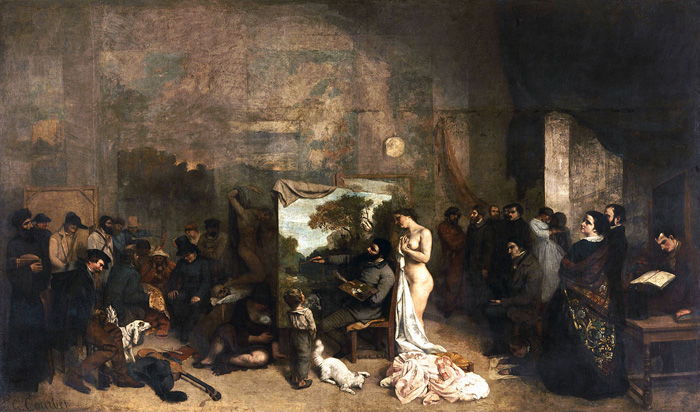A Living Art
Jacquelyn Gleisner
April 2017
 The Painter’s Atelier (L’Atelier du peintre), 1854-55, image courtesy of WikiArt.org
The Painter’s Atelier (L’Atelier du peintre), 1854-55, image courtesy of WikiArt.org
The Courage of Courbet
Rejection motivated French artist Gustave Courbet to write the first artist’s manifesto in 1855. When two of his works—Burial at Ornans and The Painter’s Atelier—were not selected by the jury of the Exposition Universelle in Paris, Courbet withdrew all of his works, including eleven accepted submissions. Burial at Ornans, nearly eleven feet tall and twenty-two feet long, was considered too large, and its subject matter—the funeral of a common man—too coarse for the exposition. Likewise, The Painter’s Atelier was not befitting among his contemporaries.
In an act of defiance, Courbet staged his own exhibition nearby in a private gallery, which he called the Pavilion of Realism (Pavillon du Réalisme). The exhibition prompted Courbet to write a bold statement outlining his attitudes about painting:
The title “realist” has been imposed upon me… Titles have never given a just idea of things; were it otherwise, the work would be superfluous… I have studied the art of the moderns, avoiding any preconceived system and without prejudice. I have no more wanted to imitate the former than to copy the latter; nor have I thought of achieving the idle aim of “art for art’s sake.” No! I have simply wanted to draw from a thorough knowledge of tradition the reasoned and free sense of my own individuality… To be able to translate the customs, ideas, and appearances of my time as I see them—in a word, to create a living art—this has been my aim. ¹
Courbet rejected the idea that he had founded a school of thought, and his text pointed to his uneasy acceptance of the term ‘realism’ in relation to his works. Nonetheless, the show—along with its radical statement—formed the Realist movement’s manifesto, the first text of this type.
Both the Pavilion of Realism and the corresponding statement allowed Courbet to respond to his critics while demarcating an important shift in thought among his circle of artists. A cadre of artists had begun to criticize the popular painting styles of the mid-19th century. In particular, the type of paintings selected for the annual juried exhibition in Paris were renounced. Instead of painting historical or fictional characters, the Realists focused on people and things that could be observed.
Courbet, like other Realists, chose working class men and women as his subjects. His decision to paint the fleshy bodies of women and his use of the palette knife underscored his investment in the visible, material world. ²
His subjects and style were a grand departure from earlier, more theatrical history paintings such as Géricault’s Raft of the Medusa (1818). Courbet’s manifesto documented an attitude shared among a growing number of artists. This courageous stance and the direct address of his critics in his text were also innovative.
Courbet was innovative in other ways, too: his text and private one-man show paved the way for another exhibition of works—the Salon Des Refusés, in 1863. Courbet set a precedent for viewers to take these works seriously, and the Salon des Refusés was received with great enthusiasm by the public. The show featured many notable artists—Paul Cezanne, Camille Pissarro, Henri Fantin-Latour—as well as the infamous painting by Edouard Manet, Luncheon on the Grass.
Courbet did not use the term “manifesto” to describe his text, but art historians have retroactively grouped his writing with numerous other artists who have codified their beliefs using this style of straightforward and impactful writing. Advocates from movements as varied as Futurism, Dadaism, and Surrealism have published manifestos. More recently, Feminists, Communists, and Stuckists have also used the format of the manifesto to further their ideas. All harken back to the Courbet’s courageous statement in 1855.
These manifestos and Courbet’s text illustrate the importance of artists using their own voices to explain their works and educate an audience. Courbet’s statement articulated his beliefs about painting in contrast to his predecessors and solidified a burgeoning art historical movement. Moreover, this text created the foundation for one of the most important events of that era, the Salon des Refusés. His dream of creating “a living art” grew into a powerful tool for artists to express, defend, and expand the dialogue about art.
¹ Gardner, H., & Kleiner, F. S. (2013). Gardner’s Art through the Ages: A Global History (14th ed.). Boston, MA: Wadsworth/Cengage Learning, 776.
² Desbuissons, F., & Payne, E. t. (2008). Courbet’s Materialism. Oxford Art Journal, 31(2), 251-260.
